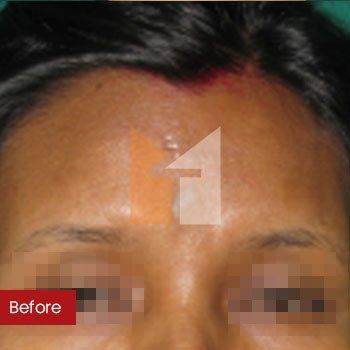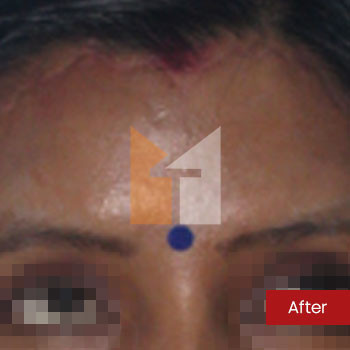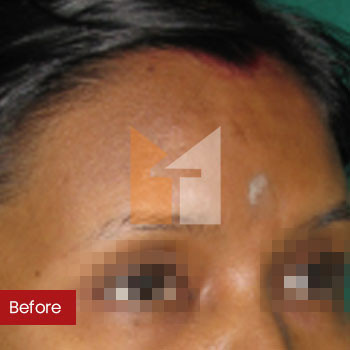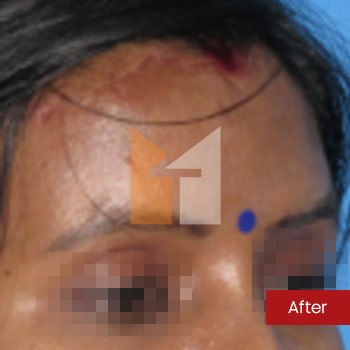Forehead Reduction
If you are unhappy with the size or appearance of your forehead and wondering how to reduce your forehead size, you can consider forehead reduction surgery. This cosmetic procedure is designed to reduce the height of your forehead by surgically removing a portion of the forehead and bringing the hairline forward.
What Is Forehead Reduction Surgery?
Forehead reduction surgery, also known as hairline lowering surgery, is a cosmetic procedure that reduces the size of the forehead by surgically removing a portion of the forehead skin near the hairline. It is often performed on patients with a high hairline or a prominent forehead, which can make a face appear disproportionate or give the appearance of a receding hairline. The procedure can also help to create a more balanced facial profile.
Forehead reduction surgery can help create a more balanced, proportionate facial appearance and improve self-confidence. The procedure typically involves making incisions along the hairline and removing a strip of forehead skin. The scalp is then pulled forward and reattached at a lower position on the forehead, effectively lowering the hairline. The surgeon may also reshape the forehead bone to reduce the size and create a smoother, more aesthetically pleasing contour.
Who Is A Good Candidate For Forehead Reduction Surgery?
A good candidate for forehead reduction surgery is someone who is generally healthy and has a high hairline or a disproportionately large forehead. You should be in good physical and emotional health and have realistic expectations about the procedure's outcome. It is essential to consult a qualified and experienced cosmetic surgeon to determine if you are a good candidate for the surgery.
Here Are Some Characteristics Of A Good Candidate For Forehead Reduction Surgery:
- Excessively High Hairline: One of the main reasons individuals undergo forehead reduction surgery is their high hairline. A good candidate for this procedure is someone with an overly high hairline and looking to move it forward to create a more proportional and balanced facial appearance.
- Realistic Expectations: Candidates need to have realistic expectations about the procedure results. While forehead reduction surgery can improve the appearance of the forehead, it cannot completely change the overall shape or size of the face.
- Good Physical Health: Candidates for forehead reduction surgery should be in good physical health, with no severe medical conditions that could affect the outcome of the surgery.
- Good Mental Health: Candidates should have good mental health and be emotionally stable, with a positive outlook and realistic expectations about the procedure.
- Non-Smoker: Smoking can increase the risk of complications during and after surgery. Therefore, candidates for forehead reduction surgery should be non-smokers or willing to quit smoking at least two weeks before and after the procedure.
- Adequate Hair Density: A candidate for forehead reduction surgery should have sufficient hair density to cover the incision sites and create a natural-looking hairline.
A consultation with a qualified cosmetic surgeon can help determine if forehead reduction surgery is the right option.
What Happens During The Procedure?
Forehead reduction surgery is typically performed under general anaesthesia. During the procedure, your surgeon will make an incision along your hairline, then remove a portion of your scalp and hairline. The remaining skin is then pulled down and sutured into place. The procedure typically takes between one and two hours to complete.
The specific techniques used during the procedure can vary depending on the patient's individual needs and goals, but here is a general overview of what to expect during forehead reduction surgery:
- Anaesthesia: Forehead reduction surgery is typically performed under local anaesthesia with sedation, which means the patient will be awake but relaxed during the procedure. General anaesthesia may also be used in some cases.
- Incision: The surgeon will make a horizontal incision along the hairline, usually from temple to temple. The length and placement of the incision will depend on the patient's individual needs and goals.
- Forehead Tissue Removal: The surgeon will remove a tissue strip from the forehead, just behind the hairline. This tissue may include skin, fat and muscle.
- Hairline Advancement: The remaining forehead tissue will be advanced and sutured at the new hairline position. It will create a lower hairline and reduce the height of the forehead.
- Incision Closure: The incision will be closed with sutures or staples. The surgeon may use tissue glue or other methods to secure the incision further.
- Recovery: After the procedure, the patient will need to rest and avoid strenuous activities for several days. Pain, swelling, and bruising are expected during the first few days but can be managed with pain medication and cold compresses. The patient may need to wear a bandage or head wrap to protect the incision site and promote healing.
- Follow-Up Visits: The surgeon will schedule several follow-up visits to monitor the healing process and remove any stitches or staples. Full recovery can take weeks to months, depending on the individual.
What Are The Risks And Complications Of Forehead Reduction Surgery?
As with any surgical procedure, forehead reduction surgery carries certain risks and potential complications. These can include infection, bleeding, scarring, nerve damage, hair loss, and unsatisfactory results. It is essential to discuss these risks with your surgeon before undergoing the procedure.
Like any surgical procedure, forehead reduction surgery carries risks and potential complications. These can include:
- Infection: As with any surgery, there is a risk of disease. Patients are typically prescribed antibiotics to help prevent infection. They should closely follow post-operative care instructions to minimize the risk.
- Scarring: Forehead reduction surgery involves incisions along the hairline, which can result in visible scarring. However, a skilled surgeon can minimize scarring by placing incisions in areas easily concealed by hair.
- Nerve Damage: There is a risk of nerve damage during forehead reduction surgery, which can result in temporary or permanent loss of sensation or muscle function in the forehead or scalp.
- Hair Loss: Depending on the extent of the procedure and the patient's hair growth patterns, hair loss or thinning around the incision site is risky. It can be temporary or permanent.
- Uneven Hairline: Achieving a symmetrical, natural-looking hairline can be challenging, and there is a risk of inconsistent or unnatural-looking results.
- Hematoma: There is a risk of hematoma, or a collection of blood under the skin, which can cause swelling, pain, and other complications.
- Anaesthesia Complications: As with any surgery, there is a risk of complications related to anaesthesia, such as allergic reactions or breathing difficulties.
What Is The Recovery Time For Forehead Reduction Surgery?
After forehead reduction, you can experience some swelling and discomfort for the first few days. You may also experience some numbness or tingling in the forehead area. Most patients can return to work and normal activities within a week to ten days. However, it may take several months for the full results of the procedure to become apparent.
How Much Does Forehead Reduction Surgery Cost?
A forehead reduction surgery cost in India can vary depending on several factors, including the surgeon's location, the extent of the procedure, and other associated costs, such as anaesthesia and facility fees. On average, the cost of forehead reduction surgery can range in the area of about a lakh Indian rupees.
What Are Some Tips For Choosing A Cosmetic Surgeon For Forehead Reduction Surgery?
When choosing a cosmetic surgeon for forehead reduction surgery, it is essential to do your research and choose a surgeon who is experienced and qualified. Look for a board-certified surgeon with a strong reputation in cosmetic surgery. It would be best if you also asked to see before-and-after photos of previous patients undergoing the procedure.
To ensure that you receive the best possible care and results, here are some tips to keep in mind when choosing a cosmetic surgeon for forehead reduction surgery:
- Look for Board Certification: Board certification is a good indicator that a surgeon has undergone rigorous training and meets high standards of professionalism and ethics. Look for a surgeon certified by the American Academy of Cosmetic Surgery or the American Board of Facial Plastic and Reconstructive Surgery.
- Check the Surgeon's Experience: When considering a surgeon for forehead reduction surgery, it is essential to find out how many procedures they have performed and their success rate. Ask the surgeon about their experience and ask to see before and after photos of previous patients who have undergone the same surgery.
- Consider the Surgeon's Reputation: Look for online reviews, testimonials, and feedback from previous patients about the surgeon you are considering. Check the surgeon's reputation with the local medical board and read any negative reviews to see if there are any red flags or patterns of issues.
- Ask About Techniques Used: Ask the surgeon about the techniques they use for forehead reduction surgery and how they will tailor the procedure to your specific needs. A reputable surgeon should be able to explain the process in detail and discuss any potential risks and complications.
- Check the Facility: Make sure the facility where the surgery will take place is accredited and meets safety standards. The facility should be equipped with modern equipment and staffed by experienced professionals.
By following these tips, you can choose a qualified and experienced cosmetic surgeon who can help you achieve the best possible results from forehead reduction surgery. Remember to do your research, ask plenty of questions, and trust your instincts when making your decision.
How Long Do The Results Of Forehead Reduction Surgery Last?
The results of forehead reduction surgery are generally permanent. It is to be noted that the hairline will not move back to its original position. However, the longevity of the results depends on various factors, such as the patient's age, genetics, and lifestyle. Aging may cause the skin to sag, which can affect the appearance of the forehead. Also, certain medications, stress, and poor lifestyle habits, such as smoking, can negatively affect the results. Therefore, following a healthy lifestyle and taking good skin care is essential to prolong the procedure results.
Can Forehead Reduction Surgery Be Combined With Other Cosmetic Procedures?
Forehead surgery can be combined with other cosmetic procedures to enhance your overall appearance further. Many people opt for a combination of techniques to achieve their desired appearance. Some of the most common cosmetic procedures that are combined with forehead reduction surgery include rhinoplasty (nose job), facelift, brow lift, eyelid surgery, and chin augmentation. Your surgeon can help you determine which combination of techniques is right for you.
Combining procedures can offer several advantages. It can reduce overall recovery time and minimize the cost of multiple methods performed separately. Additionally, connecting processes can deliver dramatic results by addressing various aspects of a person's appearance.
It is important to note that combining procedures does come with additional risks and considerations. A surgeon must evaluate a patient's overall health and medical history to determine whether it is safe to perform multiple procedures simultaneously. Additionally, the recovery process may be more challenging when various operations are performed simultaneously. Patients should be prepared for a more extended and potentially painful recovery period.
Ultimately, the decision to combine forehead reduction surgery with other cosmetic procedures should be made in consultation with a board-certified plastic surgeon who can provide personalized recommendations based on the patient's unique needs and goals.
Overall, forehead reduction surgery can be a highly effective way to achieve a more balanced, proportionate facial appearance and improve self-confidence. Patients considering the procedure should carefully weigh the potential benefits against the risks and discuss their goals and expectations with their surgeon to determine whether forehead reduction surgery is right for them.
If you are amongst those who are not satisfied with the appearance of your forehead, then considering a certified surgeon at Dr Mohan Thomas Aesthetics would be the right choice for you. We offer the most comprehensive solutions to your forehead treatment alternatives. To know more about the best face plastic surgery in India and various brow lift surgeries, get in touch with us today.




